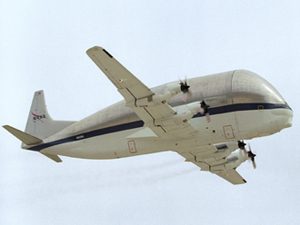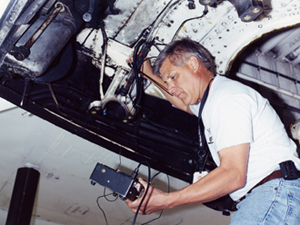|
|
.gif) |
.gif)
|
.gif) |
 |
.gif) |
.gif) |
.gif) |
Super Guppy Makes Brief Appearence
|
June 17, 2005
|
 It attracts attention
everywhere it goes, and probably inspires no small number of
UFO sightings. The bizarre-looking Super Guppy cargo transport,
the last of its kind, made a low and slow journey from Houston,
Texas, to Edwards Air Force Base April 14 for landing gear maintenance
at Dryden. It attracts attention
everywhere it goes, and probably inspires no small number of
UFO sightings. The bizarre-looking Super Guppy cargo transport,
the last of its kind, made a low and slow journey from Houston,
Texas, to Edwards Air Force Base April 14 for landing gear maintenance
at Dryden.
Image Right: After replacement of its
landing gear, NASA's Super Guppy turbine cargo plane departs Dryden, above,
for a return trip to Johnson Space Center in Texas.
"The gear had to be completely changed out," said Dryden maintenance
technician De Garcia of DynCorp. "It's routine maintenance,"
he said, on a plane whose profile is anything but routine.
Various versions of the outsize Guppy transports, built by the
now-defunct Aero Spacelines Inc. of Santa Barbara, Calif., have
been used at NASA since the days of the Apollo program. It's
a unique airplane, built to transport such bay-busting cargo
as satellites, rocket stages and jumbo-jet fuselage assemblies.
The Super Guppy is based at Ellington Field near Houston and
assigned to Johnson Space Center. DynCorp personnel are responsible
for maintaining the unusual craft that is made, in part, from
technology dating to the Second World War. Guppy transports
were built using parts of Boeing Model 377 and C-97 Stratocruisers,
passenger and cargo aircraft based on the B-29 Superfortress
bomber of World War II fame. Parts from the third prototype
Stratocruiser, built in 1948, were used in the first Guppy and
eventually were incorporated into NASA's airplane. Not surprisingly,
the bulbous craft has unique maintenance requirements.
"We needed to jack it up indoors," said Garcia, "and Dryden
has the only hangar big enough for the job." Work on the airplane
took place in Hangar 1623. Originally built to house the Lockheed
C-5 Galaxy, then the largest cargo plane in the world, the hangar
now shelters NASA's DC-8 and ER-2 aircraft.
 Image Left: Dryden flight technician De
Garcia tests equipment performance on the Super Guppy. Image Left: Dryden flight technician De
Garcia tests equipment performance on the Super Guppy.
Beginning in 1962, ASI built and operated several Guppy variants: the 377PG Pregnant Guppy, 377MG Mini
Guppy, 377SG Super Guppy, 377MGT (Mini Guppy Turbine, or Guppy 101) and the 377SGT (also known as the
Super Guppy Turbine, or Guppy 201).
The Guppy 101 crashed during FAA certification
tests at Edwards on May 12, 1970. The first 377SGT Super Guppy (N211AS) made its maiden flight on August
24 of the same year. Soon after, ASI suffered financial troubles
and eventually, the 377PG and 377MG were sold to American Jet
Corp. in Van Nuys, Calif. NASA subsequently acquired the 377SG.
ASI's board of directors decided to sell the 377SGT to France's
Airbus Industrie.
Airbus committed to purchase of one aircraft in 1970, with a
contractual commitment for ASI to build a second. After the
second was delivered Airbus ordered two more Super Guppy models. Super Guppy No. 3 flew in 1979 and No. 4 in 1980.
The four turbine-powered Super Guppy aircraft became a vital part of Airbus
Industrie's production process, operating a regularly scheduled
route five days a week. The No. 4 aircraft was later used by
the European Space Agency to transport space hardware.
In 1997, NASA acquired Super Guppy No. 4 (French registration F-GEAI) from
ESA under an International Space Station barter agreement. The
ESA supplied the Guppy to offset the cost to NASA of carrying
ESA experimental equipment to the International Space Station
as part of two future Space Shuttle flights. NASA's newest Super
Guppy crew spent four weeks in France getting
checked out on flight procedures.
On October 23, 1997, the airplane (now registered as N941NA)
landed at Ellington Field, near Houston. It replaced NASA's
377SG (N940NA), an older model of the Super Guppy, which was retired and is currently
on display at Pima Air Museum in Tucson, Ariz. N941NA is the
only Guppy still flying.
To create the 377SGT, ASI technicians built an entirely new
fuselage to connect parts taken from a Stratocruiser, including
the nose section and pressurized cockpit, wings, lower sections
of engine nacelles, parts of the tail surfaces and the main
landing gear. The nose wheel came from a Boeing 707, but it
was rotated 180 degrees prior to installation. A 23-foot center
section was inserted into the wing to give additional clearance
between the propeller tips and the fuselage. The air-conditioned
forward cabin features seating for three crew and four passengers.
The 377SGT is equipped with Allison T-56-501-D22C turboprop
engines that give the Super Guppy an airspeed of around 200 knots at low
altitudes. At higher altitudes the aircraft is limited to 185
knots. ASI took engine cowlings of the type used on Lockheed
Electra/P-3 Orion airplanes, but used propellers and spinners
from a C-130 Hercules. The P-3's propellers are built for speed,
whereas the C-130's are built for high loads. The upper nacelles
were constructed using parts from a P-3 and adapting the Lockheed
cowls to the existing lower nacelles and landing gear housing.
While building the fourth 377SGT for Airbus, ASI found that
there were no B377 or C-97 airframes left to cannibalize. They
had all been scrapped. In desperation, ASI bought lower fuselage
parts from the disassembled Pregnant Guppy and shipped them to France where they
were incorporated into the 377SGT. Hence, the last Guppy built contains parts of the first Guppy, which included parts of one of the
first Stratocruisers.
The airplane's nose is hinged on the left side of the fuselage.
The 377SGT is equipped with three built-in jacks, two in front
of the wing and one behind. These jacks support and steady the
airplane before the fuselage joint is unlocked, and the nose
opened and wheeled out of the way.
A system of rails in the cargo compartment is used with either
pallets or fixtures designed for specific cargo. An electric
winch beneath the cargo bay floor moves pallets or fixtures
on rail-mounted rollers. Automatic hydraulic lock pins in the
rail secure the pallet for flight.
The cargo hold has a maximum interior diameter of 25 feet and
overall length of just over 111 feet, with a constant 25-foot-diameter
section 32 feet long. The 377SGT's absolute volume is 49,750
cubic feet with a usable volume of 39,000 cubic feet.
After landing gear maintenance was complete, NASA's big fish
returned to Johnson May 4.
Peter Merlin
Dryden History Office
|
|
.gif) |
|




 It attracts attention
everywhere it goes, and probably inspires no small number of
UFO sightings. The bizarre-looking Super Guppy cargo transport,
the last of its kind, made a low and slow journey from Houston,
Texas, to Edwards Air Force Base April 14 for landing gear maintenance
at Dryden.
It attracts attention
everywhere it goes, and probably inspires no small number of
UFO sightings. The bizarre-looking Super Guppy cargo transport,
the last of its kind, made a low and slow journey from Houston,
Texas, to Edwards Air Force Base April 14 for landing gear maintenance
at Dryden.